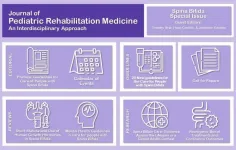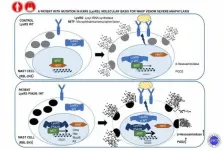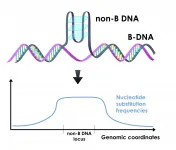(Press-News.org) Amsterdam, NL, February 9, 2021 - Globally, nearly 300,000 babies are born with neural tube defects including spina bifida (SB) each year. This openly available special issue of the Journal of Pediatric Rehabilitation Medicine (JPRM) provides 20 important evidence- and consensus-based updates to key sections of the 2018 "Guidelines for the Care of People with Spina Bifida" issued by the Spina Bifida Association (SBA). These reflect current recommendations for the care of patients with SB across the entire lifespan, from prenatal counseling to adult care.
As a result of research advancements and improved team-based patient care, approximately 80%-90% of children with SB now live to adulthood in the United States. The Guidelines were written with this idea in mind and present the best evidence for what care should be delivered, regardless of the model or types of practitioners available.
"Medical evidence and clinical practice continue to change, and so it was time to update the most recent set of Guidelines to provide the best, most up-to-date recommendations, focusing not only on pediatric care, but also on safely transitioning young adults with SB from pediatric to adult healthcare services," explained co-Guest Editors Jonathan Castillo, MD, MPH, and Heidi A. Castillo, MD, both from Developmental Pediatrics, Department of Pediatrics, Meyer Center, Texas Children's Hospital/Baylor College of Medicine, Houston, TX. "Guidelines needed to be included and/or revised to reflect the needs of adults with SB. The goal was to provide a more holistic approach to care. It is not just a condition that affects health but affects life."
Judy Thibadeau, RN, MN, Director of Research and Services, Spina Bifida Association, Arlington, VA, added, "Pediatric and adult providers need to embrace the fact that adult providers will be needed and important to the lives of people with SB."
The updated and expanded sections of the Guidelines presented in this issue move beyond more traditional issues of neurosurgical, urologic and orthopedic care, emphasize the continuum of care, health, wellbeing and quality of life, and include more background information about key topics and why they are important in the care of individuals with SB. They cover:
Bowel function and care
Central precocious puberty
Coordination of care
Family functioning in families with a child with SB
Health promotion and preventive healthcare service guidelines
Latex allergy
Mental health
Mobility
Neuropsychological care
Neurosurgical guidelines
Nutrition, metabolic syndrome, and obesity
Orthopedic guidelines
Prenatal counseling
Quality of life
Self-management and independence
Sexual health and education
Short stature and the effect of human growth hormone
Skin-related issues
Urologic guidelines
Women's health
"These Guidelines stress other issues that are important to successfully transition to adulthood including (but not limited to) family functioning, mental health, women's and men's health, and self-management skills in the broader societal and participation context," noted co-Guest Editor and SBA Medical Director Timothy John Brei, MD, Division of Developmental Medicine, Department of Pediatrics, Seattle Children's Hospital and the University of Washington School of Medicine, Seattle, WA. "These Guidelines acknowledge that one can have good medical health and still struggle in terms of independence and across the lifespan. So, they are not just about medical care across the lifespan, but 'life care.'"
In addition, neural tube defects like SB have widespread global significance. Some countries manage the care of patients with SB better than others, particularly when it relates to the care of adults with SB. Therefore, global accessibility to the Guidelines and their updates is vital, as healthcare professionals embedded in local communities will seek to use this guidance to provide high-quality care with a view towards reducing healthcare disparities. Language differences, immigration, cultural beliefs, acculturation, local resources, and social determinants of health must be taken into account when these Guidelines are implemented throughout the world.
SBA's Collaborative Care Network, through a cooperative agreement with the National Center on Birth Defects and Developmental Disabilities (NCBDDD), part of the Centers for Disease Control and Prevention (CDC), supported the production of the "Guidelines for the Care of People with Spina Bifida." These Guidelines were the culmination of three years of planning and work involving over 100 international experts using evidence-based research and consensus methodologies. The text of the Guidelines is openly available on the SBA website and the position papers in this special issue have been published open access through the support of the SBA.
"It is the hope of SBA that these and future Guidelines will promote and standardize best practice regardless of the characteristics of individuals with SB or where their care is received. It is through providing better care that we will ultimately achieve a better future for all those living with SB," remarked Brad E. Dicianno, Associate Medical Director, SBA, and Director, UPMC Adult Spina Bifida Clinic, Pittsburgh, PA.
"These open access Guidelines are paramount towards educating individuals with SB and their medical providers," commented Editor-in-Chief of JPRM Elaine L. Pico, MD, UCSF Benioff Children's Hospital Oakland, CA. "With better health and these Guidelines distributed worldwide we are looking at a robust aging population of those with SB that must be attended to by knowledgeable medical providers."
"We are so thankful to the journal for its continued focus on SB. Truly, it is a gift to our community, and we are grateful and excited to be part of what has happened thus far. We can't wait to see where this takes all of us," commented Sara Struwe, MPA, President & CEO, Spina Bifida Association, Arlington, VA. "From our community to yours, thank you!"
INFORMATION:
A study of women who were new mothers in the late 1970s found that those who were given longer, paid maternity leave lived healthier lives as they entered middle age.
While universal paid maternity leave is now available in many Western European nations, this has not always been the case. A new study by University of Georgia economist Meghan Skira looked at the health of Norwegian mothers before and after paid maternity leave became law in 1977. She found that the health benefits of leave continued for years after their children were born.
Skira, an associate professor in the Terry College of Business, worked with economist Aline Bütikofer of the Norwegian School of Economics and Julie Riise of the University of Bergen on the study. Their paper, "The Impact of Paid ...
A study led by researchers at the University of Minnesota Medical School found a way to detect the presence of ovarian cancer in patients using Pap test samples, normally used to detect cervical cancer. Currently, no early warning system exists for ovarian cancer, which in 2021, is estimated to kill more than 13,700 women, according to the American Cancer Society.
"It is known as a 'silent killer' since women with early stages of ovarian cancer have symptoms that can often be confused with other ailments. Women are typically diagnosed when the cancer has progressed so far that other organs are involved, requiring major surgery and chemotherapy," ...
Russian researchers from HSE University have studied a hypothesis regarding the capability of the visual system to automatically categorize objects (i.e., without requiring attention span). The results of a simple and beautiful experiment confirmed this assumption. The paper was published in the journal Scientific Reports. The study was supported by a Russian Science Foundation grant.
Humans receive a lot of information from the environment through their vision. Every day, we face a flow of varied visual stimuli. At the same time, information processing requires cognitive resources. Like a computer processor, the human brain has limited capacity in terms of the data it is able to process and save ...
Anaphylaxis is a systemic allergic reaction that can affect the skin, the gastrointestinal tract, the respiratory system and the cardiovascular system. The most severe form of anaphylaxis is anaphylactic shock, which features hypotension and can cause death. This reaction can have several causes, such as allergic reactions to food, medicines or insect venom.
The molecular mechanisms that cause the severity of these kinds of reactions is still unknown. In a study led by researchers of the University of Barcelona and IDIBAPS, researchers analyzed the mutation of a gen detected in a patient who suffered from recurrent anaphylactic shocks caused ...
Growing the right crop in the right place within an impaired watershed can achieve significant water quality improvements, according to Penn State researchers, who conducted a novel study in the drainage of a Susquehanna River tributary in an agricultural area in southeastern Pennsylvania.
The research may reveal a potential path for restoring the troubled Chesapeake Bay, said Patrick Drohan, associate professor of pedology in the College of Agricultural Sciences and one of the study's authors. The bay -- which long has been impaired in large part by nutrients and sediment washing off crop fields and getting into surface waters that feed it -- needs bold solutions, such as changing cropping systems, he suggested.
"Other than when wastewater treatment plants came into compliance ...
BROOKLYN, New York, Monday, February 8, 2021 -- A holy grail for orthopedic research is a method for not only creating artificial bone tissue that precisely matches the real thing, but does so in such microscopic detail that it includes tiny structures potentially important for stem cell differentiation, which is key to bone regeneration.
Researchers at the NYU Tandon School of Engineering and New York Stem Cell Foundation Research Institute (NYSF) have taken a major step by creating the exact replica of a bone using a system that pairs biothermal imaging with a heated "nano-chisel." In a study, "Cost and Time Effective Lithography of Reusable Millimeter Size Bone Tissue Replicas with Sub-15 nm Feature Size on a Biocompatible ...
A team of researchers from the Laboratory of Biophysics at NUST MISIS, Lomonosov Moscow State University and D. Mendeleev University of Chemical Technology of Russia has summarized metal-containing diagnostic agents for positron emission tomography (PET), magnetic resonance imaging (MRI), and single-photon emission computed tomography (SPECT) imaging of Alzheimer's disease (AD). According to the researchers, metal-containing radiopharmaceuticals are not only highly effective for detecting early markers of Alzheimer's disease, but also synchrotron-independent and ...
Bats are the only mammals that can actively fly. Some species travel over one hundred kilometres on their nocturnal excursions in search of food. Researchers at the Max Planck Institute of Animal Behavior in Radolfzell have now discovered that European free-tailed bats use uplifting winds for their ascents - a behaviour that was previously known only from birds. To do this, they tracked the bats using mini GPS loggers and then linked the flight data to weather data. The animals can thus gain altitude of well over 1,000 metres without expending much energy. The results ...
DNA sequences that can fold into shapes other than the classic double helix tend to have higher mutation rates than other regions in the human genome. New research shows that the elevated mutation rate in these sequences plays a major role in determining regional variation in mutation rates across the genome. Deciphering the patterns and causes of regional variation in mutation rates is important both for understanding evolution and for predicting sites of new mutations that could lead to disease.
A paper describing the research by a team of Penn State scientists is available online in the journal Nucleic Acids Research.
"Most of the time we think about DNA as the classic ...
A 'biological age' score predicts that being male, overweight, a smoker and having depression all contribute to biological aging, a study published today in eLife reports.
Aging can be measured in different ways. While chronological age is measured by date of birth, scientists have developed a range of measurements to determine our biological age. These include measuring the length of telomeres (little caps on the end of our chromosomes that shorten as we grow older), chemical changes to our DNA (epigenetics), and changes to the proteins and metabolites in our bodies ...






